sensor RENAULT KANGOO 1997 KC / 1.G Engine And Peripherals Owner's Guide
[x] Cancel search | Manufacturer: RENAULT, Model Year: 1997, Model line: KANGOO, Model: RENAULT KANGOO 1997 KC / 1.GPages: 208
Page 147 of 208

STARTING - CHARGING
Starter motor
16
OPTIMA 5800 Diagnostic station
CHECKING THE STARTER MOTOR USING THE DIAGNOSTIC STATION
Checking of the starter motor is carried out using the OPTIMA 5800, by measuring the battery voltage and
the current absorbed in the engine starting phase. The following operation faults may be highlighted :
- a fault in the battery ( the voltage falls during the starting phase),
- locking of the starter motor (the current absorbed is too high),
- a fault in the engine starter gear (the current absorbed is too low).
In order to carry out the measurement, it is necessary to stop the vehicle from starting :
- for D7F and E7J engines : disconnect the engine speed sensor (located on the clutch housing ,
- for
F8Q engines : disconnect the pump electrical solenoid and isolate the terminal.
NOTE :
- an open circuit on the engine speed sensor or the ignition creates a fault memorised by the injection
computer, this fault must then be erased from the memory using the
XR25 (see "Injection" section),
- if the engine is fitted with an immobiliser, it is sufficient to lock the doors using the remote control.
FAULT FINDING
SPECIAL TOOLING REQUIRED
16-8
Page 151 of 208
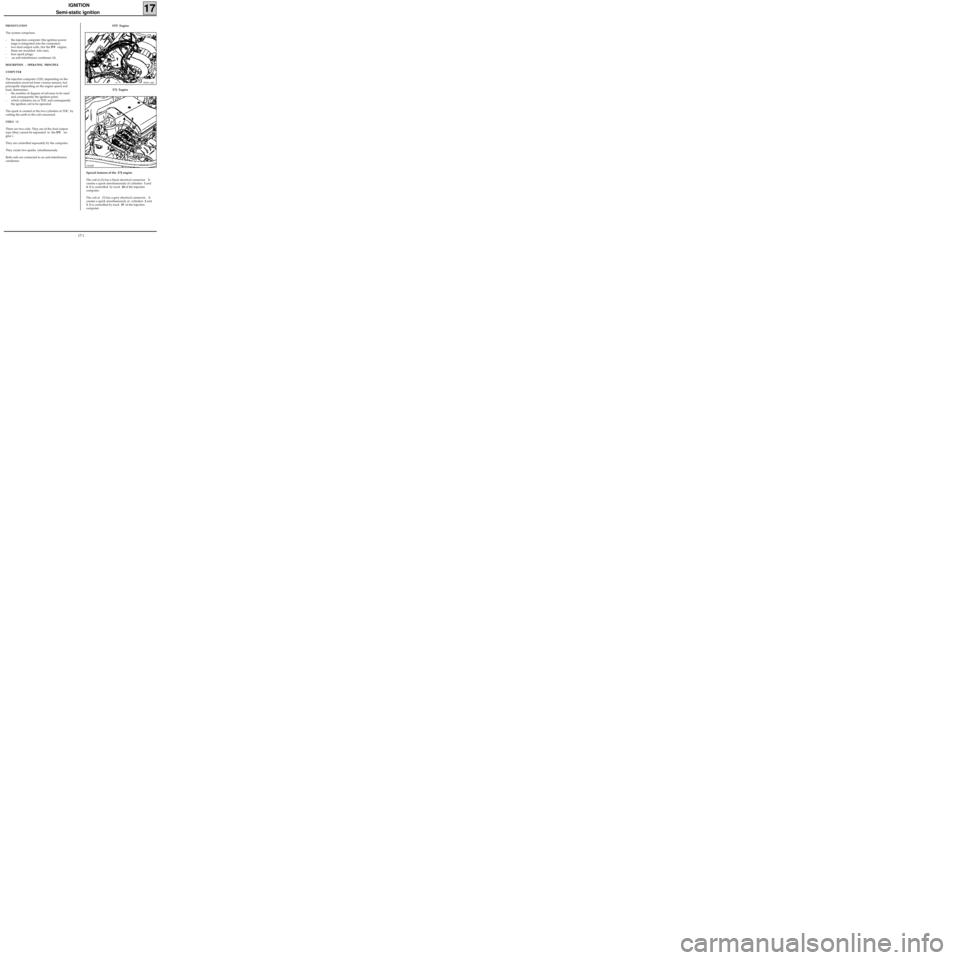
IGNITION
Semi-static ignition
17
PRESENTATION
The system comprises:
- the injection computer (the ignition power
stage is integrated into the computer),
- two dual output coils, (for the
D7F engine,
these are moulded into one),
- four spark plugs,
- an anti-interference condenser (4).
DESCRIPTION - OPERATING PRINCIPLE
COMPUTER
The injection computer (120), depending on the
information received from various sensors, but
principally depending on the engine speed and
load, determines:
- the number of degrees of advance to be used
and consequently the ignition point,
- which cylinders are at TDC and consequently
the ignition coil to be operated.
The spark is created at the two cylinders at TDC by
cutting the earth to the coil concerned.
COILS (1)
There are two coils. They are of the dual output
type (they cannot be separated in the
D7F en-
gine ).
They are controlled separately by the computer.
They create two sparks simultaneously.
Both coils are connected to an anti-interference
condenser.
99931-1R2
D7F Engine
E7J Engine
13242R
Special features of the E7J engine
The coil at (2) has a black electrical connector. It
creates a spark simultaneously at cylinders 1 and
4. It is controlled by track 28 of the injection
computer.
The coil at (3) has a grey electrical connector . It
creates a spark simultaneously at cylinders 2 and
3. It is controlled by track 29 of the injection
computer.
17-1
Page 156 of 208
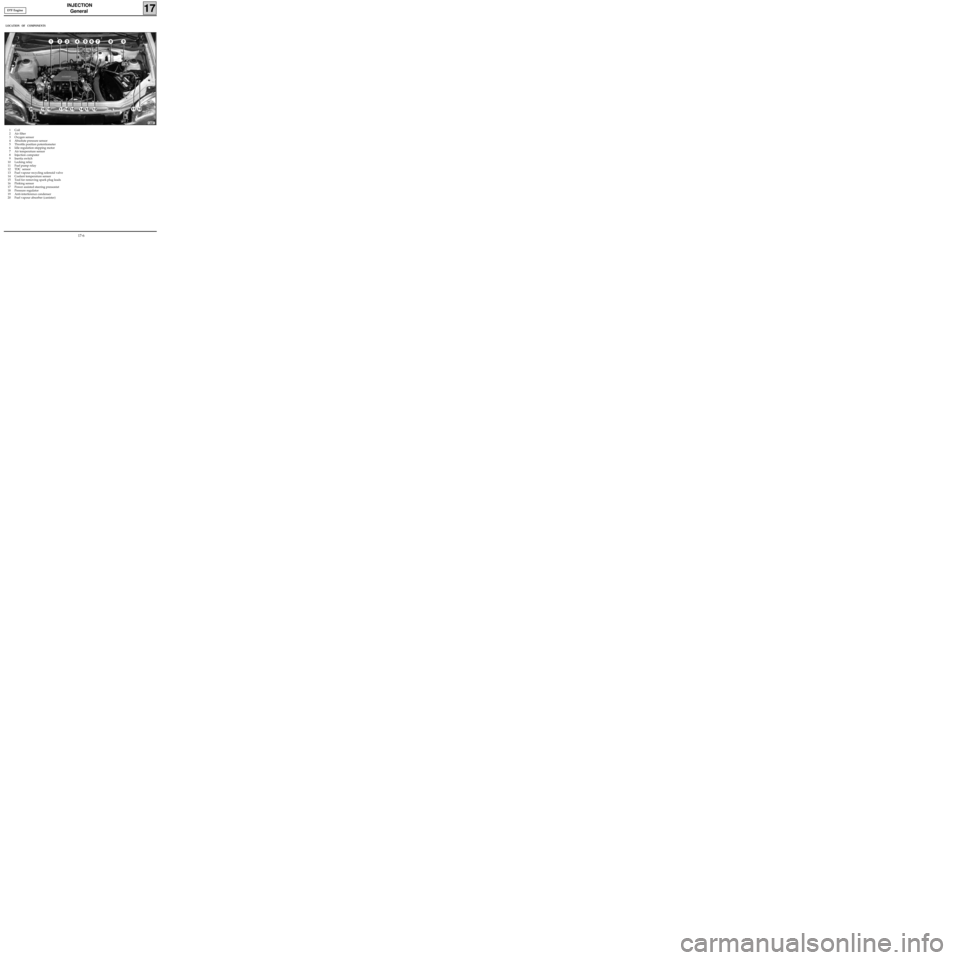
INJECTION
General
17
1 Coil
2 Air filter
3 Oxygen sensor
4 Absolute pressure sensor
5 Throttle position potentiometer
6 Idle regulation stepping motor
7 Air temperature sensor
8 Injection computer
9 Inertia switch
10 Locking relay
11 Fuel pump relay
12 TDC sensor
13 Fuel vapour recycling solenoid valve
14 Coolant temperature sensor
15 Tool for removing spark plug leads
16 Pinking sensor
17 Power assisted steering pressostat
18 Pressure regulator
19 Anti-interference condenser
20 Fuel vapour absorber (canister)
LOCATION OF COMPONENTS
13081
D7F Engine
17-6
Page 157 of 208
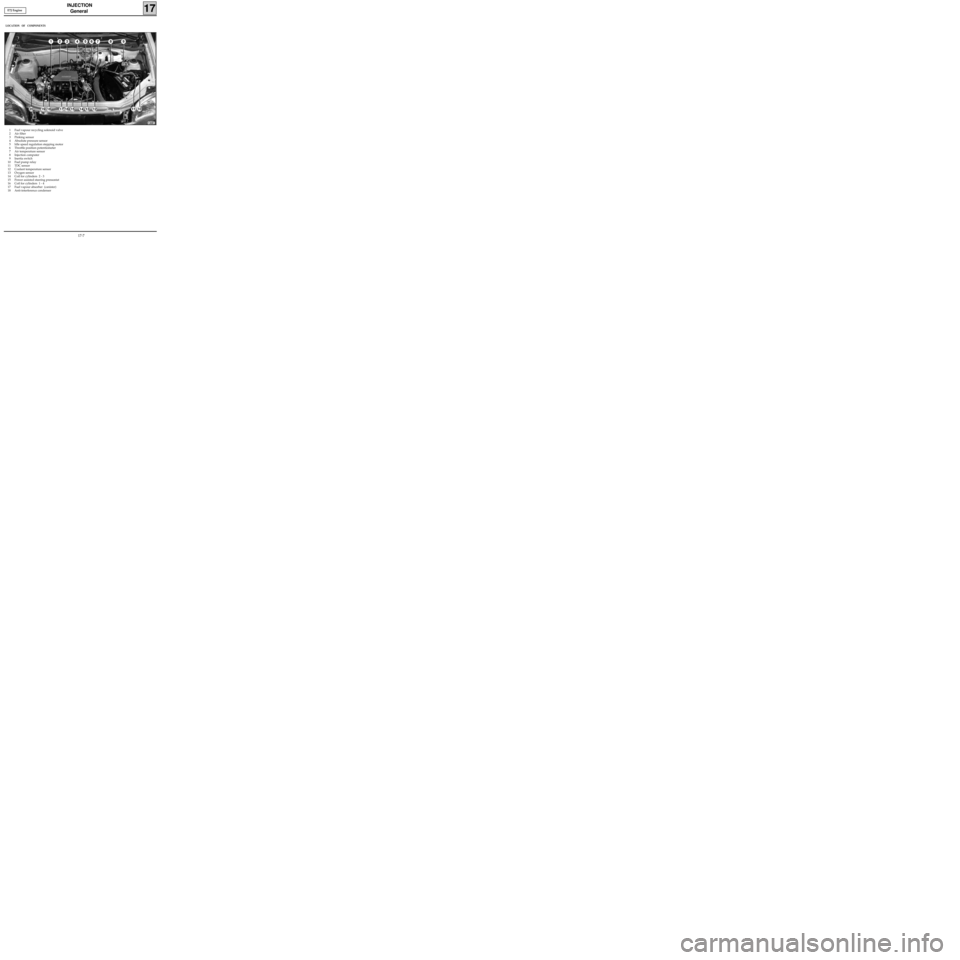
INJECTION
General
17
1 Fuel vapour recycling solenoid valve
2 Air filter
3 Pinking sensor
4 Absolute pressure sensor
5 Idle speed regulation stepping motor
6 Throttle position potentiometer
7 Air temperature sensor
8 Injection computer
9 Inertia switch
10 Fuel pump relay
11 TDC sensor
12 Coolant temperature sensor
13 Oxygen sensor
14 Coil for cylinders 2 - 3
15 Power assisted steering pressostat
16 Coil for cylinders 1 - 4
17 Fuel vapour absorber (canister)
18 Anti-interference condenser
LOCATION OF COMPONENTS
13082
E7J Engine
17-7
Page 158 of 208
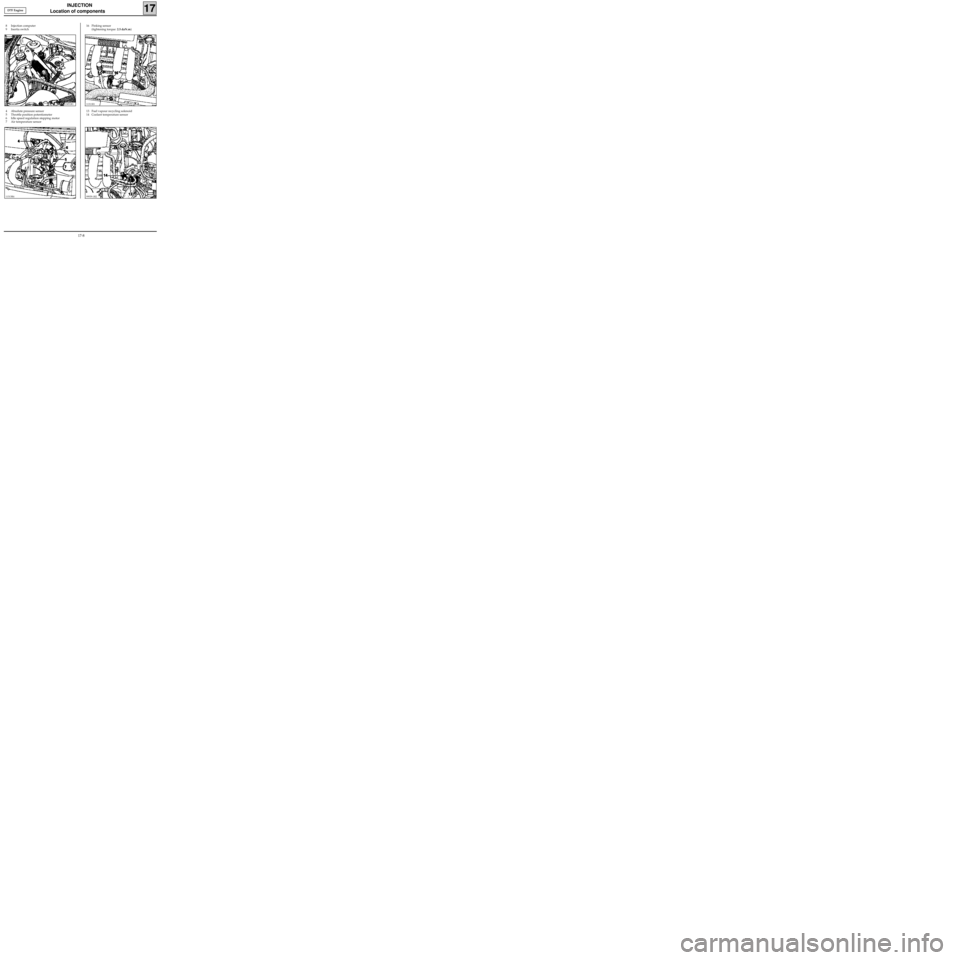
INJECTION
Location of components
17
4 Absolute pressure sensor
5 Throttle position potentiometer
6 Idle speed regulation stepping motor
7 Air temperature sensor13 Fuel vapour recycling solenoid
14 Coolant temperature sensor 16 Pinking sensor
(tightening torque: 2.5 daN.m)
11313R4
11311R1
99939-1R2
8 Injection computer
9 Inertia switch
13051R1
D7F Engine
17-8
Page 159 of 208
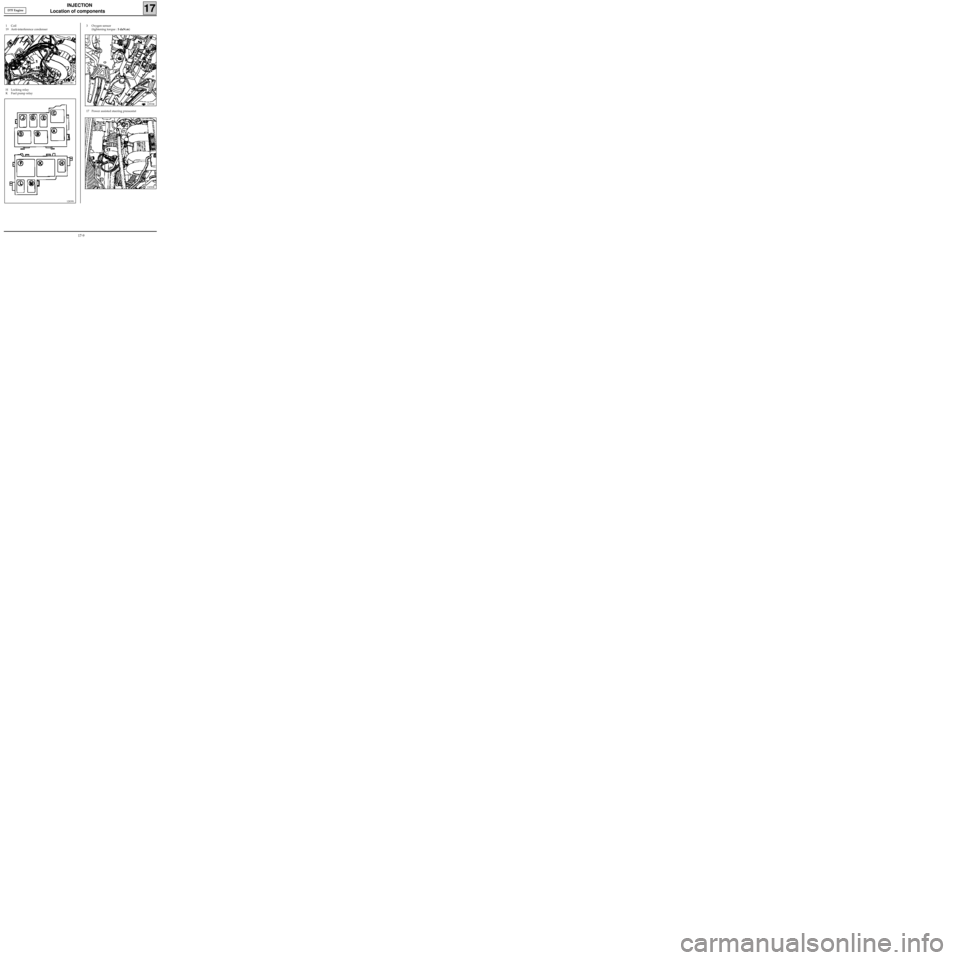
INJECTION
Location of components
17
H Locking relay
K Fuel pump relay
3 Oxygen sensor
(tightening torque : 5 daN.m)
12993R
1 Coil
19 Anti-interference condenser
99931-1R1
12839S
17 Power assisted steering pressostat
13050R
D7F Engine
17-9
Page 160 of 208

INJECTION
Location of components
17
12 Coolant temperature sensor8 Injection computer
9 Inertia switch
13240R
3 Pinking sensor
(tightening torque: 2.5 daN.m)
13336R13239R
E7J Engine
17-10
Page 161 of 208
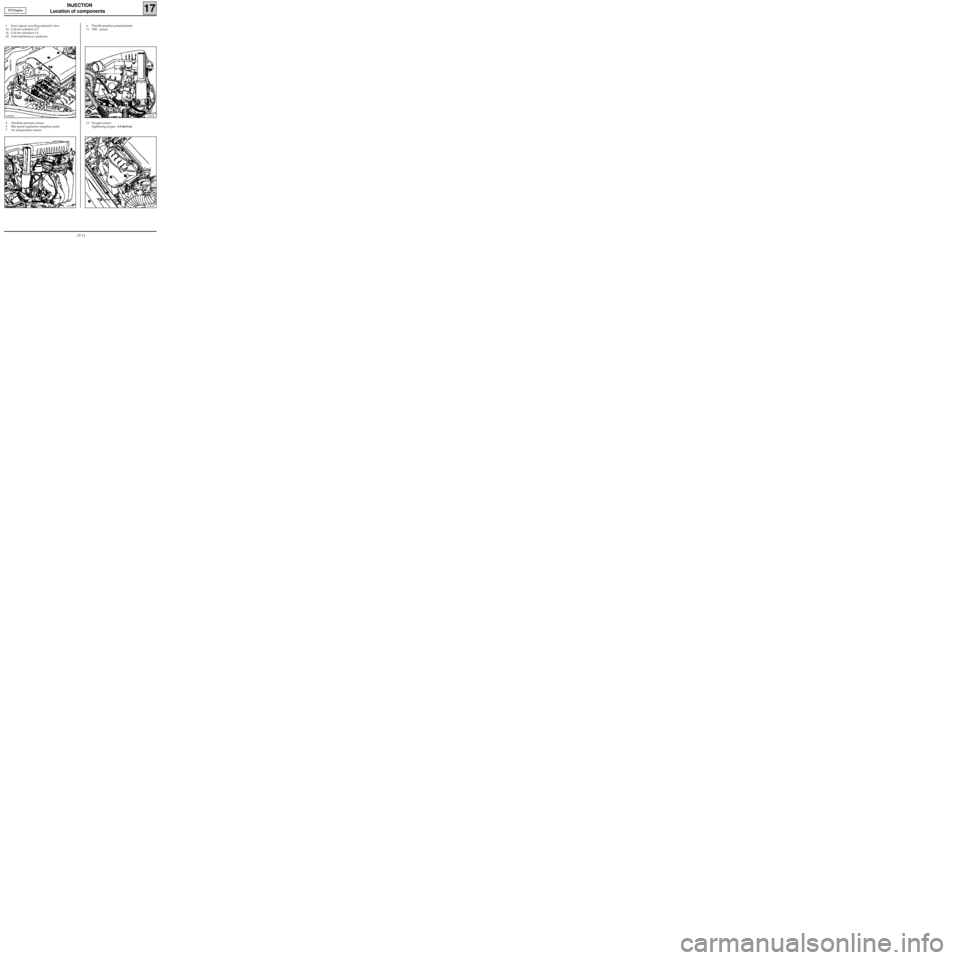
INJECTION
Location of components
17
4 Absolute pressure sensor
5 Idle speed regulation stepping motor
7 Air temperature sensor6 Throttle position potentiometer
11 TDC sensor
13337R
1 Fuel vapour recycling solenoid valve
14 Coil for cylinders 2-3
16 Coil for cylinders 1-4
18 Anti-interference condenser
13242R1
13339R
13 Oxygen sensor
(tightening torque : 4.5 daN.m)
13243R
E7J Engine
17-11
Page 163 of 208
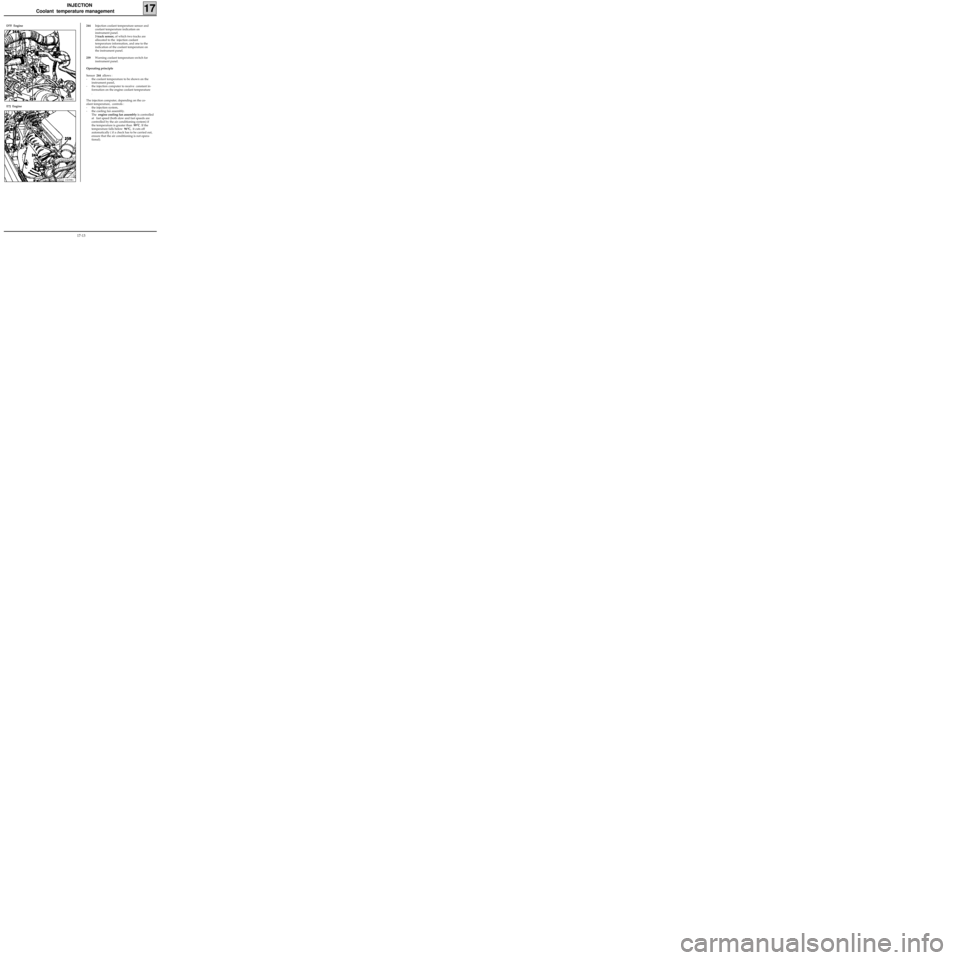
INJECTION
Coolant temperature management
244Injection coolant temperature sensor and
coolant temperature indication on
instrument panel.
3 track sensor, of which two tracks are
allocated to the injection coolant
temperature information, and one to the
indication of the coolant temperature on
the instrument panel.
259Warning coolant temperature switch for
instrument panel.
Operating principle
Sensor 244 allows :
- the coolant temperature to be shown on the
instrument panel,
- the injection computer to receive constant in-
formation on the engine coolant temperature
.
The injection computer, depending on the co-
olant temperature, controls :
- the injection system,
- the cooling fan assembly.
The engine cooling fan assembly is controlled
at fast speed (both slow and fast speeds are
controlled by the air conditioning system) if
the temperature is greater than 99°C. If the
temperature falls below 96°C, it cuts off
automatically ( if a check has to be carried out,
ensure that the air conditioning is not opera-
tional).
17
11634R2
D7F Engine
13239R1
E7J Engine
17-13
Page 164 of 208
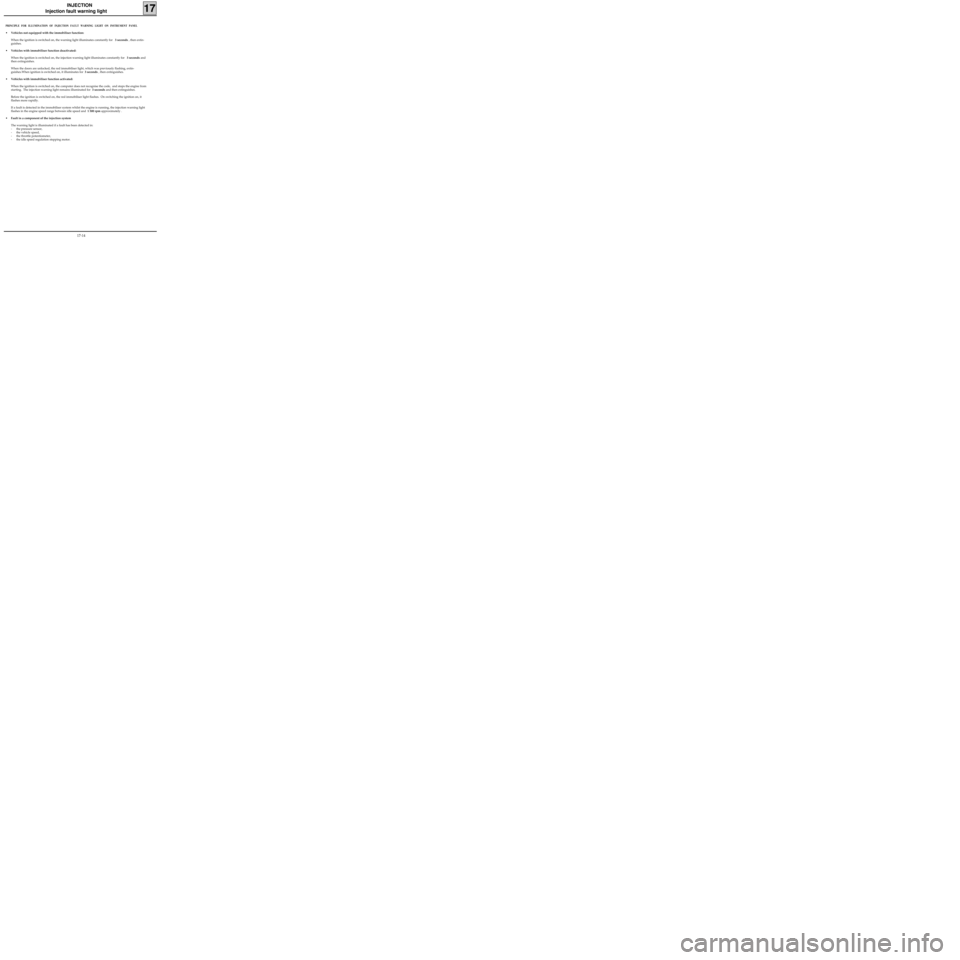
INJECTION
Injection fault warning light
17
PRINCIPLE FOR ILLUMINATION OF INJECTION FAULT WARNING LIGHT ON INSTRUMENT PANEL
• Vehicles not equipped with the immobiliser function:
When the ignition is switched on, the warning light illuminates constantly for 3 seconds , then extin-
guishes.
• Vehicles with immobiliser function deactivated:
When the ignition is switched on, the injection warning light illuminates constantly for 3 seconds and
then extinguishes.
When the doors are unlocked, the red immobiliser light, which was previously flashing, extin-
guishes.When ignition is switched on, it illuminates for 3 seconds , then extinguishes.
• Vehicles with immobiliser function activated:
When the ignition is switched on, the computer does not recognise the code, and stops the engine from
starting. The injection warning light remains illuminated for 3 seconds and then extinguishes.
Before the ignition is switched on, the red immobiliser light flashes. On switching the ignition on, it
flashes more rapidly.
If a fault is detected in the immobiliser system whilst the engine is running, the injection warning light
flashes in the engine speed range between idle speed and 1 500 rpm approximately .
• Fault in a component of the injection system
The warning light is illuminated if a fault has been detected in:
- the pressure sensor,
- the vehicle speed,
- the throttle potentiometer,
- the idle speed regulation stepping motor.
17-14